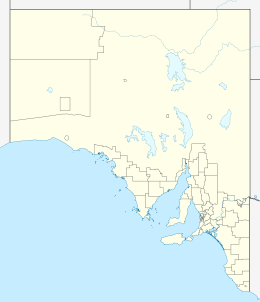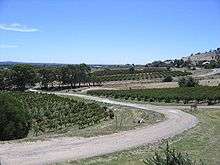Barossa Valley
| Barossa Valley South Australia | |
|---|---|
 Tanunda is surrounded by vineyards showing Autumn colour. | |
 Barossa Valley The location of Tanunda, one of the key towns in the region. | |
| Coordinates | 34°32′S 138°57′E / 34.533°S 138.950°ECoordinates: 34°32′S 138°57′E / 34.533°S 138.950°E |
| Population | 20,000 (2006; approx.)[1] |
| • Density | 20/km2 (52/sq mi) (approx.) |
| Area | 912 km2 (352.1 sq mi)[2] |
| Time zone | ACST (UTC+9.5) |
| • Summer (DST) | ACDT (UTC+10.5) |
| Location | 60 km (37 mi) NE of Adelaide city centre |
| LGA(s) | Barossa Council, Light Regional Council |
The Barossa Valley is a valley in South Australia located 60 kilometres (37 mi) northeast of Adelaide city centre and which is notable as a major wine-producing region and tourist destination. It is the valley formed by the North Para River, and the Barossa Valley Way is the main road through the valley, connecting the main towns on the valley floor of Nuriootpa, Tanunda, Rowland Flat and Lyndoch.
History

The Barossa Valley derives its name from the Barossa Ranges, which were named by Colonel William Light in 1837. Light chose the name in memory of the British victory over the French in the Battle of Barrosa, in which he fought in 1811. The name "Barossa" was registered in error, due to a clerical error in transcribing the name "Barrosa". The area is approximately 13 by 14 kilometres (8.1 by 8.7 mi).
The three major towns of the Barossa all have distinctive personalities. Tanunda is generally recognised as the most German of the three with long-standing traditions dating back to the 1840s when the first German settlers arrived in the area. Because many of them came from Prussian Silesia, they called the Barossa Neu-Schlesien, or "New Silesia".[3] The German influence survives to this day (see Barossa German). Angaston, in contrast, is considered the English town as it was settled predominantly by Cornish miners and others from Britain. The third (and largest) town, Nuriootpa, was influenced by both the German and British settlers, and today is the commercial hub of the Barossa where most of the larger stores are located. Tanunda and Angaston are considered 'tourist towns' in comparison to Nuriootpa because they have many more facilities to cater for tourists.
In February 2011, South Australian Premier Mike Rann announced that special legislation would be introduced to protect the unique heritage of the Barossa Valley and McLaren Vale. Premier Rann said: "Barossa and McLaren Vale food and wine are key icons of South Australia. We must never allow the Barossa or McLaren Vale to become suburbs of Adelaide."[4] The Character Preservation (Barossa Valley) Act 2012 was subsequently passed by the South Australian Parliament.[5]
People
Currently, the Barossa Valley has a population of about 20,000, most of whom live in Tanunda, Nuriootpa, Angaston, Williamstown and Lyndoch, each having over 1000 people, with a few smaller towns such as Moculta and Springton. All of these towns are part of the Barossa local government. Many facilities not available in these towns are usually supplemented in nearby Gawler. In recent years, increased development in the area has seen opposition from the local communities.
Religion
The region has a strong German Lutheran history, and many residents identify themselves as Lutherans. Some towns have more than one Lutheran church. Tanunda, for example, has Langmeil, St. Paul's, Tabor and St. Johns. Nuriootpa has St. Petri and Holy Trinity. Angaston has Zion and Salem (Penrice).
Each major town also has a Lutheran primary school. Tanunda has Tanunda Lutheran School, Nuriootpa has Redeemer, and Angaston has Good Shepherd. St. Jakobi, the Lutheran primary school at Lyndoch, hosts the Barossa Airshow annually as its fundraiser.
Population
Major Town Populations:
| Rank | Urban Centre | Population, 2006 census |
|---|---|---|
| 1 | Nuriootpa | 4,414[6] |
| 2 | Tanunda | 4,153[7] |
| 3 | Angaston | 1,865[8] |
| 4 | Williamstown | 1,432[9] |
| 5 | Lyndoch | 1,415[10] |
| 6 | Greenock | 685[11] |
| 7 | Mount Pleasant | 593[12] |
As a rural region, there is also significant population outside of the town centres (not shown here).
Wine industry

The wine industry plays a major role in the Barossa, being the main source of employment for many residents. The many hectares of vineyard are the most distinctive feature of the area, especially when viewed from the Mengler Hill lookout positioned on the range of hills that form one side of the valley itself. The success of the wine industry has historically been celebrated every two years with a week-long Barossa Valley Vintage Festival. The festival draws visitors from all over the world and has entertainment for all tastes including a huge street parade, concerts and gourmet dining.
The Barossa Valley is primarily known for its red wine, in particular Shiraz. Normally[13] large proportions of Barossa Shiraz is used in Penfolds Grange (Australia's most famous wine).[14] Other main grape varieties that grown in the region include: Riesling; Semillon; Grenache and Cabernet Sauvignon. There are also some fortified wines traditionally produced in the region.
The Barossa Valley is a rich source of some of the oldest Shiraz vines in the world. Shiraz vines planted as early as 1847 by Johann Frederick August Fiedler on Lot 1, Hundred of Moorooroo (the township of Tanunda) are still in commercial production today by Turkey Flat Vineyards.[15]
Food production
Although it is overshadowed by the wine industry, significant food production occurs in the Barossa Valley,[16] including:
- Angas Park Fruit Company which produces dried fruit at Angaston.
- Bakeries like Apex Bakery in Tanunda, Linkes in Nuriootpa, Lyndoch Bakery in Lyndoch, and Sunrise in Angaston all of whom produce traditional German breads and pastries.
- Butchers who produce meats, mettwurst and other smallgoods in the German style, including Schultz Butchers at Angaston, Mount Pleasant Butchers at Mount Pleasant, Steiny's Traditional Mettwurst at Tanunda.
- Cheesemakers such as Barossa Valley Cheese Co.[17] in Angaston, and Ballycroft Artisan Cheese in Greenock.
- Maggie Beer,[18] a writer, a former restaurateur[19] and co-presenter of ABC Television's programme The Cook and The Chef, who produces pâtés, fruit pastes, jams, jellies, glazes, preserves, olive oil, verjuice, vinegars, herbs and spices, soups and ice cream.
Barossa foods have a reputation for their quality and local production is increasing. Barossa food products are sold in local markets and shops, and served in local cafés and restaurants. Many are exported internationally, and to other parts of Australia for sale through retailers or for restaurant use. Among some popular foods that are sold at the Barossa market are fruit tarts, pies, gourmet sandwiches and freshly made deli items.
The Barossa Valley holds a popular weekly Farmers' Market, supplying local produce which is sold directly by the producer.[20]
Festivals
Barossa Vintage Festival
The week-long Barossa Vintage Festival is held biennially, in odd-numbered years. The festival runs for around a week in autumn, and traditionally marks and celebrates the completion of the year's vintage season, at the end of March and beginning of April. A variety of wine-themed events are held during the festival, including wine tastings and competitions, musical events, food events with local produce, balls and parades.
The Barossa Vintage Festival was first held in 1947, to celebrate the end of the grape harvest, and the end of hostilities in World War II, and has run continually since. It is Australia's oldest and longest-running wine festival.[21]
Barossa... Be Consumed Gourmet Weekend
The Barossa... Be Consumed Gourmet weekend is a three-day food, wine and art celebration held in the third weekend of August every year. Local wineries and venues host individual events throughout the Barossa, offering food, wine, music, arts and hospitality.[22]
See also
References
- ↑ See Population
- ↑ "Archived copy" (PDF). Archived from the original (PDF) on 12 March 2011. Retrieved 2011-03-07.
- ↑ LeRoy R. Hafen. Broken Hand. U of Nebraska Press, 1981. ISBN 0-8032-7208-1
- ↑ 891 ABC, Feb 9, 2011:"No Urban Sprawl into Wine Region"
- ↑ Rau, John (18 January 2013). "McLaren Vale and Barossa protected from today" (PDF). Government of South Australia. Retrieved 12 November 2014.
- ↑ Australian Bureau of Statistics (25 October 2007). "Nuriootpa (Urban Centre/Locality)". 2006 Census QuickStats. Retrieved 4 November 2012. Map
- ↑ Australian Bureau of Statistics (25 October 2007). "Tanunda (Urban Centre/Locality)". 2006 Census QuickStats. Retrieved 4 November 2012. Map
- ↑ Australian Bureau of Statistics (25 October 2007). "Angaston (Urban Centre/Locality)". 2006 Census QuickStats. Retrieved 4 November 2012. Map
- ↑ Australian Bureau of Statistics (25 October 2007). "Williamstown (Urban Centre/Locality)". 2006 Census QuickStats. Retrieved 4 November 2012. Map
- ↑ Australian Bureau of Statistics (25 October 2007). "Lyndoch (Urban Centre/Locality)". 2006 Census QuickStats. Retrieved 4 November 2012. Map
- ↑ Australian Bureau of Statistics (25 October 2007). "Greenock (L) (Urban Centre/Locality)". 2006 Census QuickStats. Retrieved 4 November 2012. Map
- ↑ Australian Bureau of Statistics (25 October 2007). "Mount Pleasant (L) (Urban Centre/Locality)". 2006 Census QuickStats. Retrieved 4 November 2012. Map
- ↑ White, Robert E. Soils for Fine Wines. Oxford University Press, USA, 2003. p. 245 ISBN 0-19-514102-4
- ↑ Gordon, Kieth and Debra. Wine on Tuesdays: Be a Serious Wine Drinker without Taking Wine Too Seriously. Thomas Nelson, 2008. p. 136 ISBN 1-4016-0418-8
- ↑ http://www.turkeyflat.com.au/blog/tag/history
- ↑ http://www.foodbarossa.com/
- ↑ http://www.barossacheese.com.au/
- ↑ http://www.maggiebeer.com.au/
- ↑ Her restaurant was called The Pheasant Farm, which drew people from a wide area including Adelaide, and became renowned as one of Australia's leading and most innovative restaurants. http://www.maggiebeer.com.au/maggiewrites/history/. The Pheasant Farm is now Maggie Beer's trademark name under which most of her products are sold.
- ↑ http://www.barossafarmersmarket.com
- ↑ "Archived copy". Archived from the original on 19 February 2011. Retrieved 2011-03-07.
- ↑ http://www.barossagourmet.com
External links
 Barossa Valley travel guide from Wikivoyage
Barossa Valley travel guide from Wikivoyage- SouthAustralia.com South Australian Government tourism webpage
- Barossa Council official site
- Barossa Grape & Wine Association wine & tourism webpage
- RDA Barossa